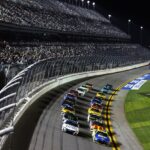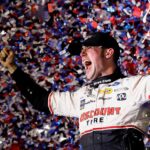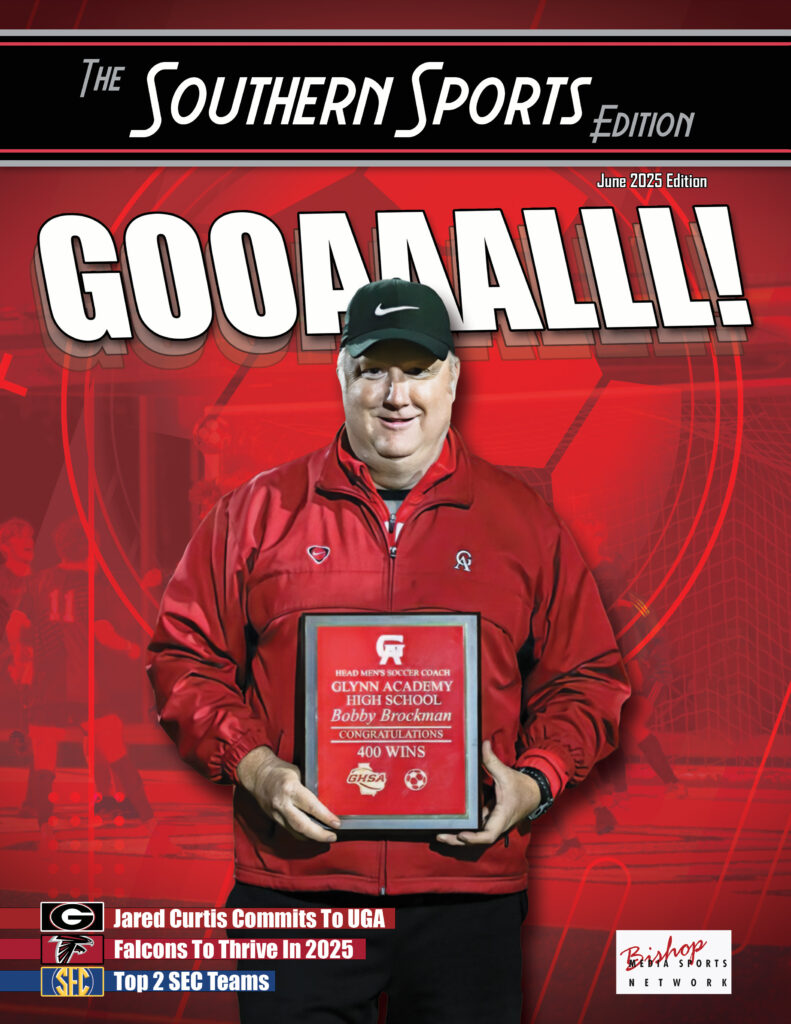NASCAR
Gentleman, Start Your Engines
 By: Robert Craft
By: Robert Craft
TheSouthernSportsEdition.com news services
The Super Bowl is the pinnacle of a long successful season for NFL teams.
In NASCAR, they have the Daytona 500. It’s the first race of the season and also the most prestigious event on the circuit.
The stars of the Cup Series are all set to be in Daytona on February 16 to run in the crown jewel of stock car to open the regular season, including defending Cup champion Joey Logano.
Several stars will be running to earn their first Daytona 500 victory, including Chase Elliott, Kyle Busch and Kyle Larson.
Dale Earnhardt Jr., JR Motorsports, will attempt to make its’ Cup Series debut in next month’s season-opening Daytona 500, the team announced Wednesday.
JRM is partnering with country singer and songwriter Chris Stapleton to enter a car for driver Justin Allgaier, with Stapleton’s Traveller Whiskey brand sponsoring the effort.
Earnhardt, a two-time Daytona 500 winner (2004, 2014), has publicly spoken many times about how he’d like to see JRM expand into Cup on a full-time basis, though he’s emphasized that any move would have to make financial sense for the company.
Thus far, such a move has proven cost-prohibitive at a time when charters — the NASCAR equivalent of a franchise in other sports — are valued at $20 million plus.
Owning one of 36 charters guarantees a team certain revenue streams not otherwise available, making operating as a full-time “open” not cost-effective over the long term.
Helio Castroneves, four-time Indianapolis 500 winner and one of the more popular drivers of his generation, will make his NASCAR debut in next month’s Cup Series season-opening Daytona 500, Trackhouse Racing announced Monday. Castroneves will drive a car fielded by Trackhouse Racing.
The majority of Castroneves’ 20-year plus career has been spent in IndyCar, winning 31 races and being runner-up to the championship four times. His most notable accomplishment is being part of an exclusive group who’ve won the Indianapolis 500 a record four times, with only A.J. Foyt, Rick Mears and Al Unser Sr. as the other members.
Should Castroneves win the Daytona 500, he would join Foyt and Mario Andretti as the only drivers to win both the Daytona 500 and Indianapolis 500.
When two-time Formula One world champion Fernando Alonso failed to qualify for the 2019 Indianapolis 500, it sent a message to the world: This IndyCar stuff isn’t easy.
To just award a 41st starting spot in a field that has been capped at 40 cars for the last decade — just because the driver is famous to international fans — doesn’t align with the true spirit of competition.
Oh, and former NASCAR champions Jimmie Johnson and Martin Truex Jr.? They’ll show up at Daytona to qualify into the 500 with no guarantee they’ll make the field, just like any other driver.
Except the more famous ones, that is. Castroneves has no such concerns and going forward, any other celebrity who fits NASCAR’s definition won’t have to worry, either. This is as much of a marketing event as it is a sporting event, and big names draw big crowds.
Some of the other storylines in the field center around NASCAR’s biggest stars and all-time great drivers who have a stake in both the Daytona 500 and NASCAR history at hand.
Denny Hamlin is looking to become only the third driver in history to win this race more than three times, and a fourth victory would tie him for second all-time with Cale Yarborough.
Seven-time Cup champion Jimmie Johnson, who is becoming the first driver to ever make a Cup start after being named to the NASCAR Hall of Fame.
He can also move out of a tie with Yarborough for sixth in NASCAR’s all-time wins list if he earns his third Daytona 500 win; the 84th of his Cup career overall.
Either accomplishment for Hamlin and Johnson would be a fitting tribute to Yarborough, one of NASCAR’s greatest drivers ever, who passed away this offseason at the age of 84.
Another driver with something at stake is Joey Logano, the 2015 Daytona 500 champion and this year’s polesitter. Should Logano earn his second Daytona 500 win, he would become the first driver to win the 500 from the pole since Dale Jarrett in 2000.
Buckle up NASCAR fans, this Daytona 500 will be a new and exciting event to kick off the Cup Series.
History Lesson
 By: Charles Skipper
By: Charles Skipper
TheSouthernSportsEdition.com news services
Daytona International Raceway was the site of the 64th running of the Daytona 500 recently.
The mecca of Stock Car Racing held its first 500-mile race on the track built by NASCAR founder Bill France Sr. on February 22, 1959.
The winner’s trophy for the inaugural race went to a fellow with the last name of Petty but not the Petty you might think it was.
Lee Petty, not “The King” Richard Petty was victorious that Sunday afternoon. The driver of the #43 Petty Blue car did manage to take the checkered flag at the iconic racetrack seven times and is the all-time leader in wins in the event.
The Daytona racetrack was the first Superspeedway to be built and the new venue replaced the Daytona Beach Road Course, which included a portion of the race being ran on the beach itself.
Vintage film footage of the cars flying down the beach at breakneck speeds illustrate the love for speed in the early years of automobiles.
The picturesque beach course was not designed just for looks as there were 15 World Land Speed records set there, with speeds reaching a whopping 211 mph during the race.
Races were first held in 1936 on the course and continued until it closed in 1958 after the opening of the new track.
Bill France, a garage owner/operator in Daytona Beach, whom had been a race car driver himself, began managing the road course in 1938. France believed people wanted to watch stock car races and began talks in a motel bar on Daytona Beach that led to the formation of the National Association of Stock Car Auto Racing. This group is still the governing and operating company for stock car racing today.
The next move France made to lead NASCAR into the future was to plan the building of a new track in Daytona.
The legendary high banked turns in Daytona were utilized to foster more speed and to allow the fans to see the cars better.
The Father of NASCAR patterned the banking on the Florida track after the Ford Motor Company Proving Grounds, which had banking to allow for faster speeds in their test cars. The new banked tri-oval became the fastest track in the series until Talladega opened ten years later.
The Daytona 500 has grown from these roots to the pinnacle race of the NASCAR season.
Every other sport you can think of holds their signature event at the end of their season and the winner of that culminating event is the champion for that season. NASCAR comes right out of the gate with their top event first on the schedule.
The design of the Super Speedway track leads to a style of racing where the cars form long lines of cars at speeds near or at 200 mph in a row usually inches from the bumper of the car in front of them.
This combination has led to many exciting finishes like the Cale Yarborough-Donnie Allison fight after a crash on the last lap of the 1979 race.
These wrecks sometimes though have ended in tragedy such as the one that took the life of NASCAR legend Dale Earnhardt in 2001.
Through the highs and lows of the track’s fabled history, the Daytona 500 has become the most important and prestigious race on the NASCAR circuit, bringing in the highest television ratings and by far has the largest purse awarded.
The Super Bowl of Stock Car Racing signals the beginning of a new NASCAR season each year and entertains millions of fans along the way.
The brainchild of Bill France Sr. continues to thrive today and live up to the title it was given as The Great American Race.
Jimmie
 By: JJ Lanier
By: JJ Lanier
TheSouthernSportsEdition.com news services
With the exception of a few years in the mid to late 2000’s where I was a casual watcher, I’ve never really been a fan of NASCAR.
It’s not that I had anything against it, watching racing just wasn’t my thing.
However, as Jimmie Johnson’s full-time career comes to an end- and I say full time because race car drivers are like WWE wrestlers, they never seem to completely retire- I can’t help but think back on how he was perceived during that time.
Now, just to be clear, I’m not talking about his legacy- I’m not nearly knowledgeable enough to make those kinds of assessments. I’m referring to how he was viewed among most NASCAR fans, and why.
Johnson entered NASCAR as Jeff Gordon 2.0. He was a good looking, well dressed, articulate speaking (no accent) individual, which meant the ladies loved him and the men, not so much.
The fact he drove for the same owner as Gordon, Richard Hendrick, led to me hearing them referred to as the “Backstreet Boys of racing” on more than one occasion.
It would be easy to put the lion’s share of Johnson’s struggle to win over the diehard fan on him being an outsider, but it goes a little deeper than that.
NASCAR is a tight knit community where names like Petty, Wallace, and Allison mean something; and no name carries more weight in that sport than Earnhardt.
I honestly think had Earnhardt been around the Hatfield and McCoy’s feud would’ve ended with “…and they all gathered around the table in their Earnhardt shirts, thanking the good lord for placing the Intimidator on this earth.”
Fan loyalty runs deeper in NASCAR than any other sport, so to have a racer like Jimmie Johnson winning five straight Cup Series Championships over Dale Earnhardt Jr. was blasphemy at its highest level.
It would’ve been bad enough to have a racer like Tony Stewart or Kevin Harvick defeating Earnhardt Jr. when it was supposed to be his time, but for those defeats to come at the hands of a pretty boy from California was unacceptable.
If Johnson was your average racer, winning a race or two here and there, I still think fans would’ve had the same opinion of him, it just wouldn’t have been nearly as deep seeded.
(I feel like I need to mention I don’t ever remember Earnhardt Jr. and Johnson having any issues with each other, outside of the normal confrontations all drivers seem to have with each other some point. Like most things related to sports, it had nothing to with the drivers themselves, but rather the fans.)
I also believe Johnson’s popularity with the casual NASCAR fan outside of the south was a major reason the sport reached its peak around that time- something I think the diehard fan had difficulty coming to grips with.
If I had to guess it’s been ten years since I, not only watched a NASCAR race, but actually followed what was taking place. I have no idea if Johnson’s popularity within the sport has increased over that time or if it’s stayed the same; I imagine it’s gotten better, but probably not by much.
I have no idea where Johnson ranks among the pantheon of great race car drivers, but for a few years he was one of the more polarizing drivers in the sport, and NASCAR was all the better for it.






